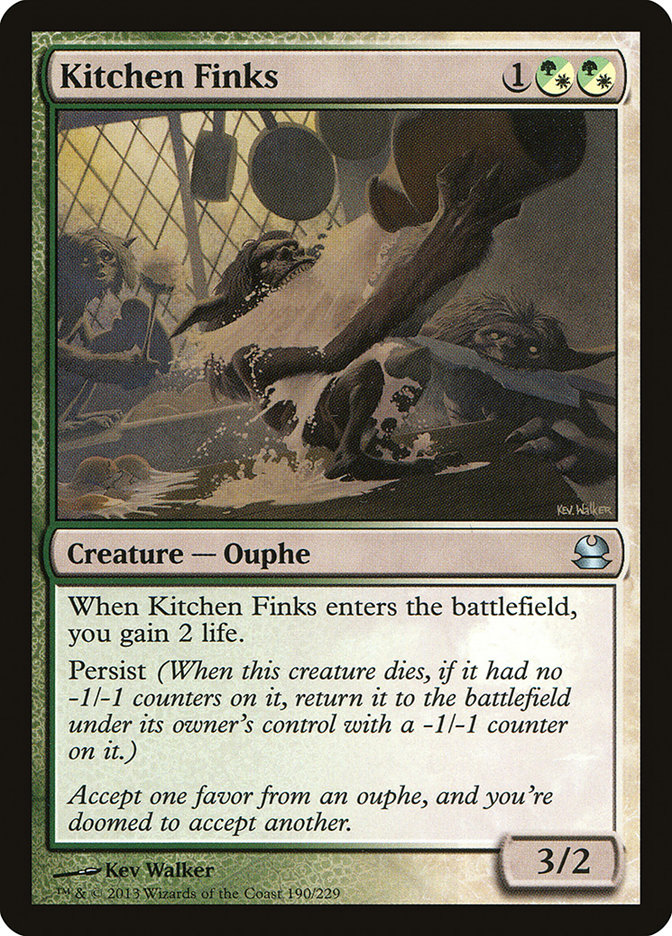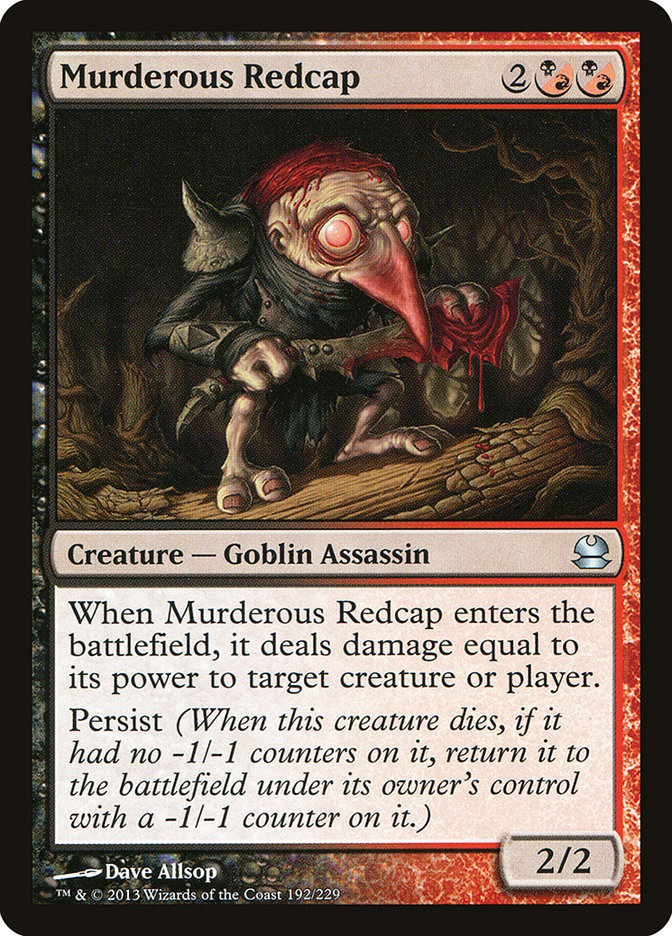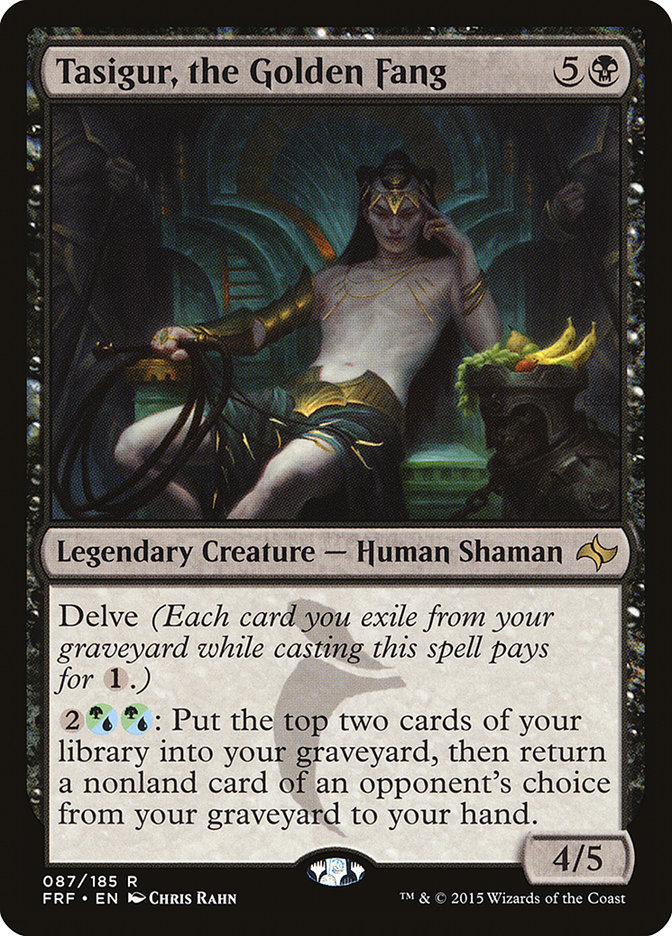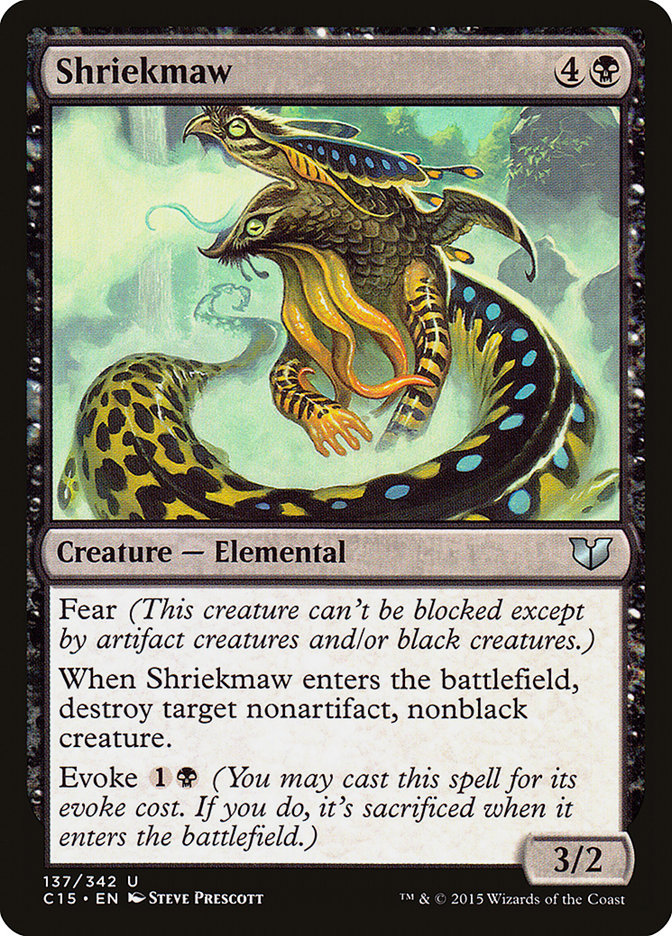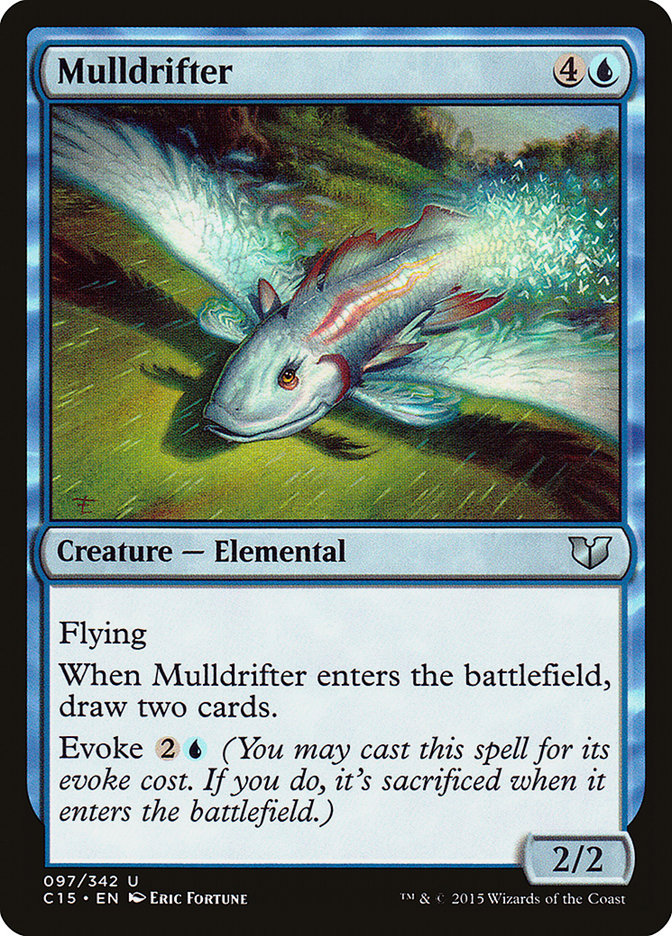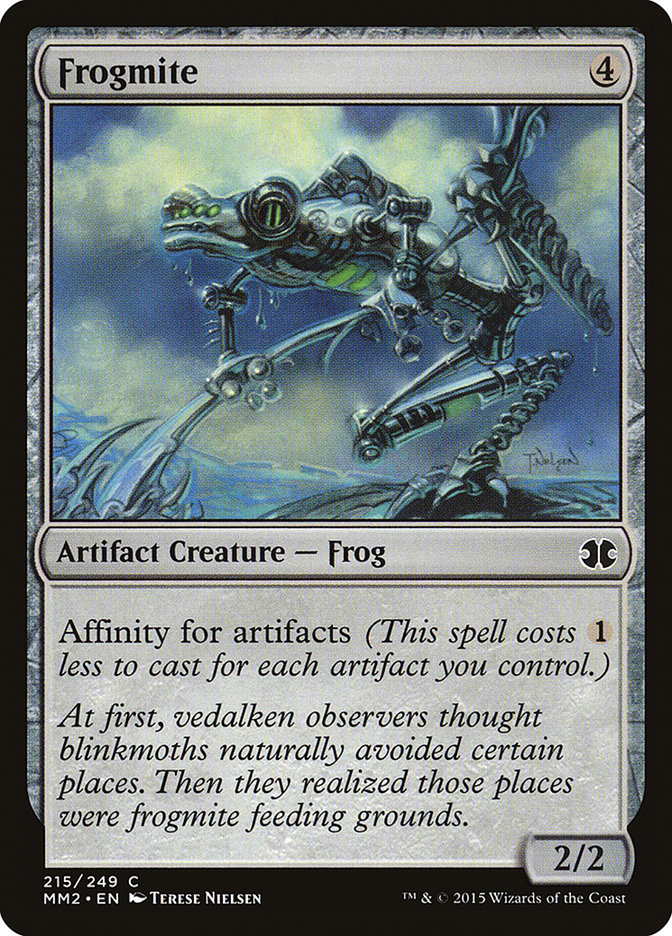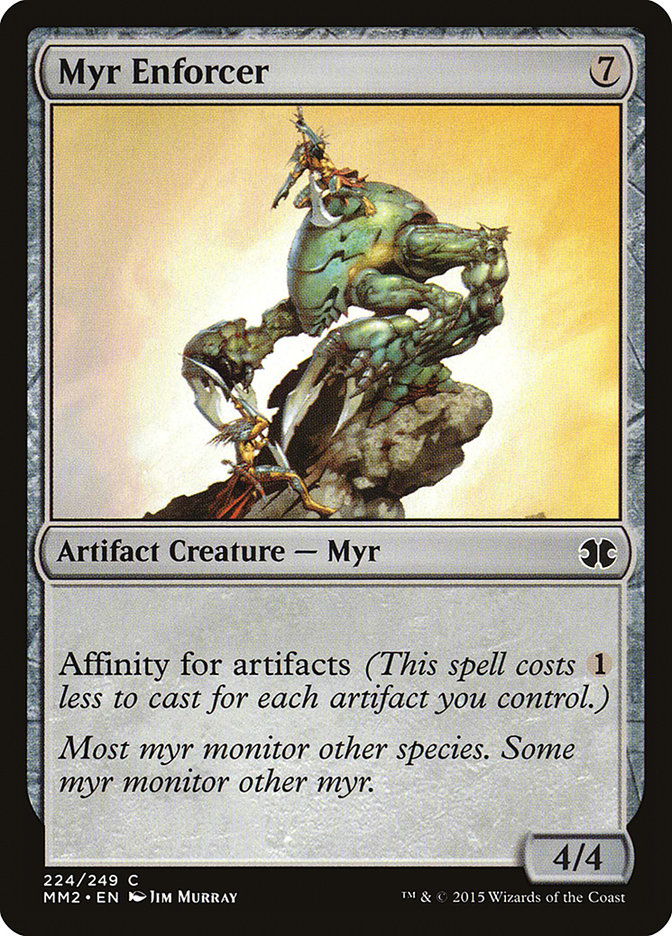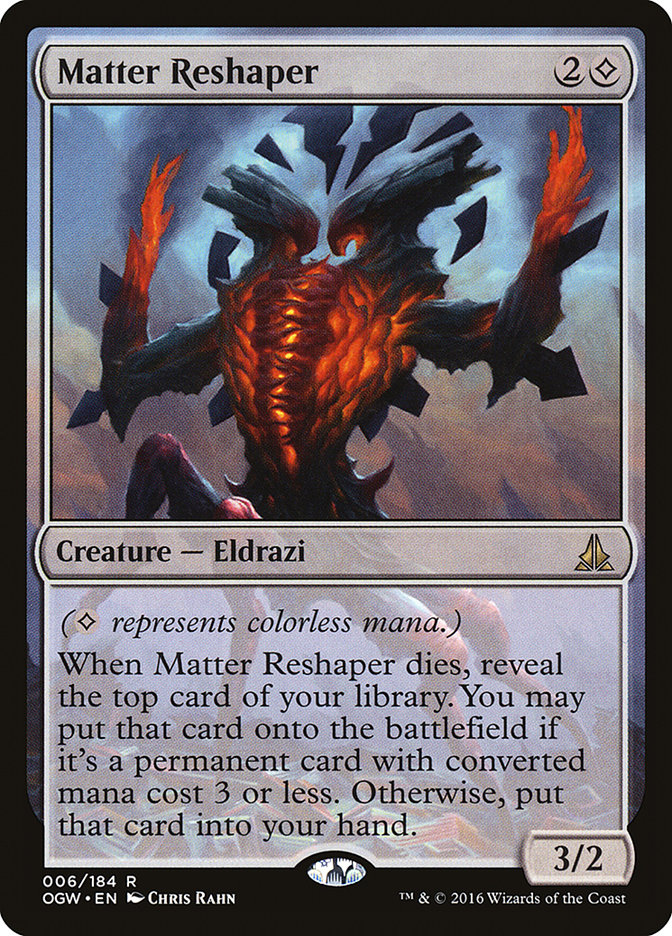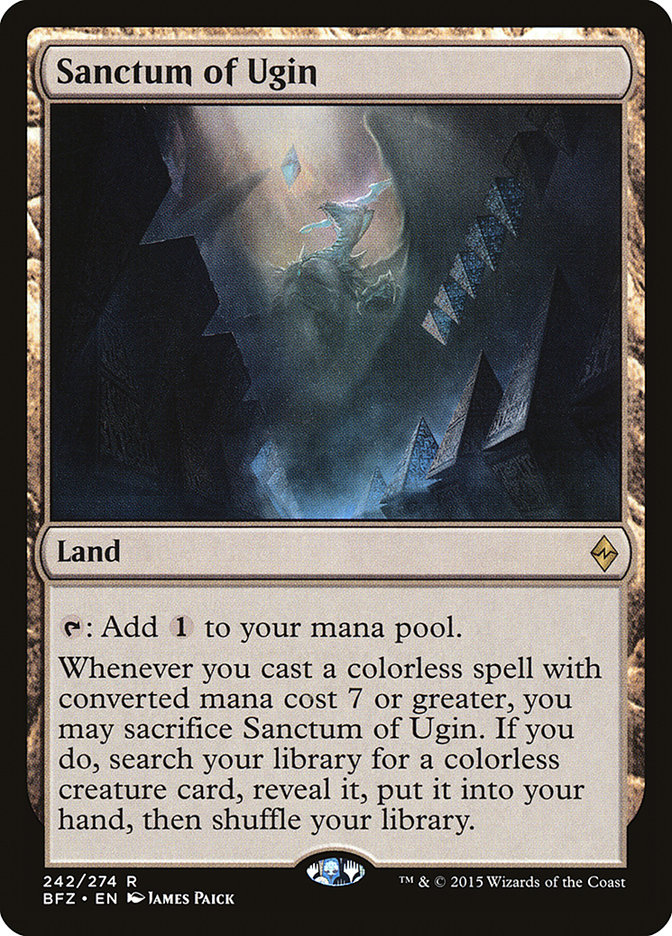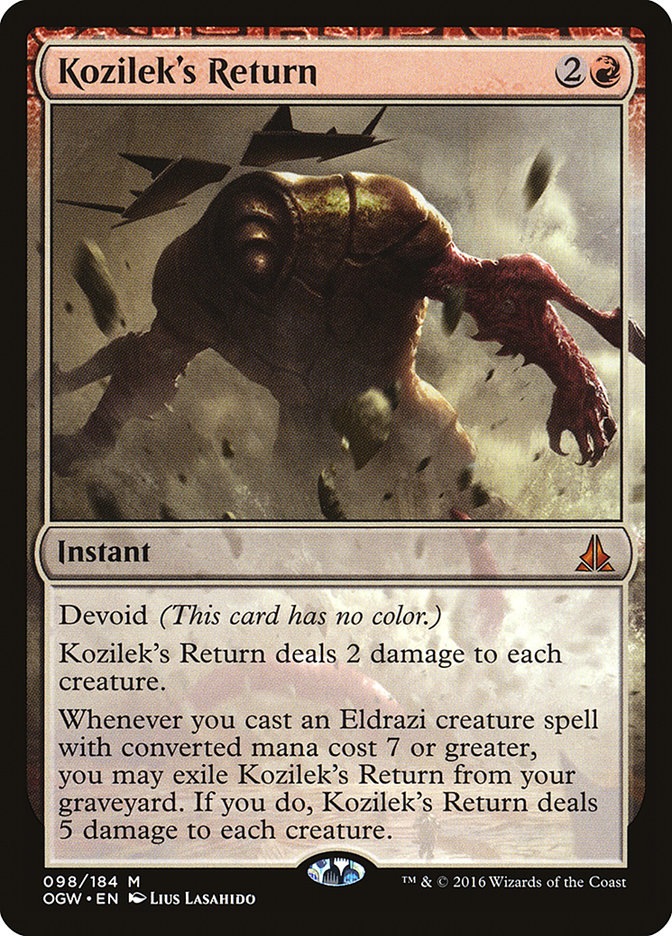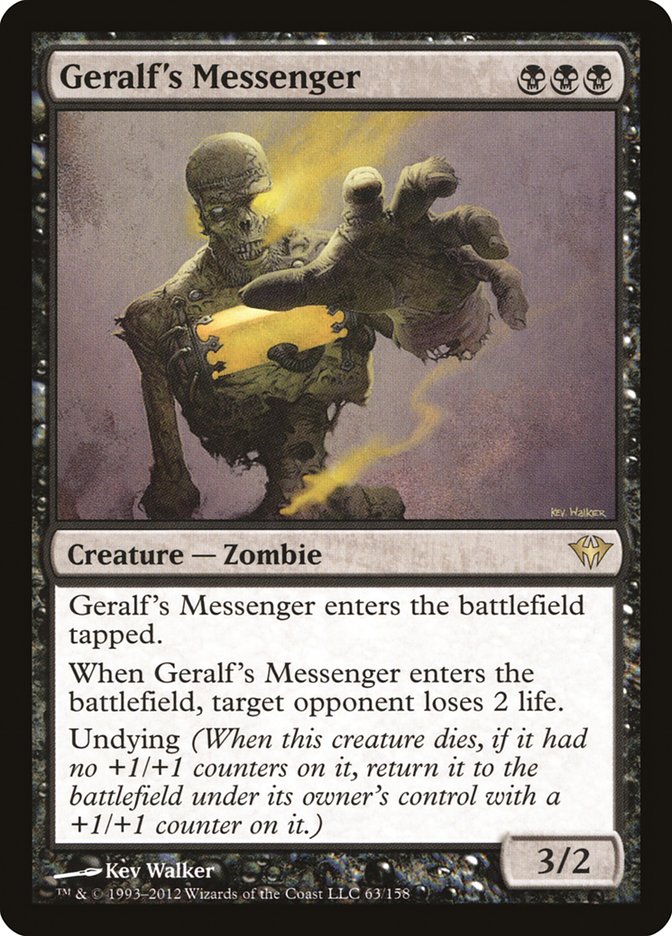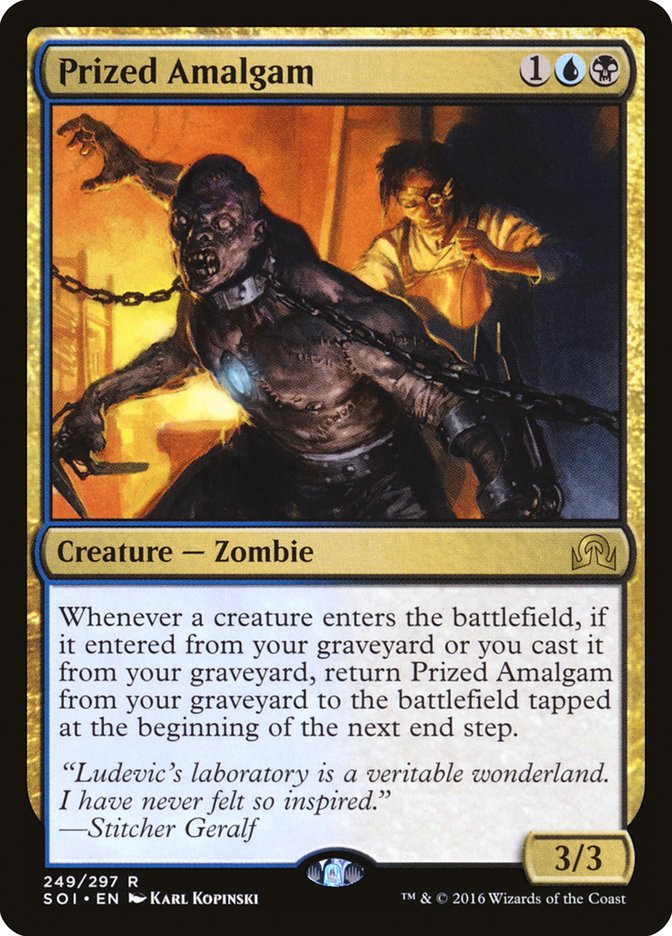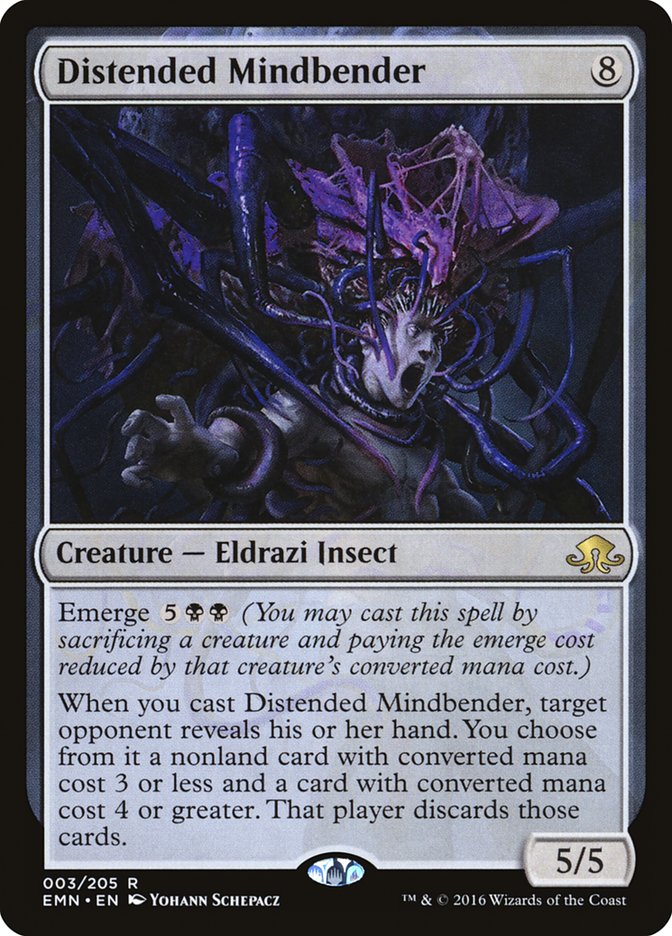This week I’m basically going to be hammering you over the head with decklists. I will be featuring both “normal” Modern archetypes and a brew or two.
The reason for that should really come as no surprise. I think emerge is broken and that it will inevitably invade Modern as well.
I won’t suggest that these lists are well-tuned but rather that they should help you get the gears turning.
There are a ton of backward ways to successfully fuel emerge in such an expanded card pool and it isn’t even clear in some of these decks that I have chosen the correct emerge threat to build around.
As a concise way to organize this, here are all the key cards and mechanics that I’ve looked at to exploit the emerge Eldrazi:
Persist:
Delve:
Evoke:
Affinity:
General Support:
Let’s get started with the lists:
Creatures (19)
- 3 Eternal Witness
- 4 Tarmogoyf
- 4 Kitchen Finks
- 1 Murderous Redcap
- 3 Scavenging Ooze
- 1 Tasigur, the Golden Fang
- 3 Distended Mindbender
Lands (25)
Spells (17)

This deck has approximately nine enablers for Distended Mindbender between Kitchen Finks, Eternal Witness, Murderous Redcap, and Tasigur, the Golden Fang. In essence I am trading Liliana of the Veil and the ability to start working an opponent down to both players being hellbent quickly for a bigger game with some more built-in resiliency to aggressive strategies.
Jund actually gets to effectively leverage Kozilek’s Return and there’s no guarantee that, despite losing some small amount of incidental discard, Distended Mindbender isn’t more powerful in combo or big mana matchups.
While Liliana of the Veil over the course of several turns can put those decks in the soft lock, for the first several turns your opponent will, of course, be discarding their worst card. There’s no guarantee that they can’t just kill you before the squeeze gets too tight.
I actually like Eternal Witness being a crutch of this deck due to the plethora of cheap interaction and the deck’s willingness to hit high mana counts for Raging Ravine, so despite the fact that there’s no longer the threat of curving a discard spell into Dark Confidant, I don’t think there’s a real drop in power here.
Creatures (29)
- 4 Birds of Paradise
- 2 Eternal Witness
- 4 Tarmogoyf
- 4 Kitchen Finks
- 3 Noble Hierarch
- 2 Sin Collector
- 4 Siege Rhino
- 1 Tasigur, the Golden Fang
- 1 Distended Mindbender
- 4 Abundant Maw
Lands (25)
Spells (6)

Rather than take on a traditional Abzan Midrange list, I think it makes a lot more sense to approach the aggressive strategy. Here we are basically substituting Wilt-Leaf Liege for the ability to play upwards of twelve Siege Rhinos. Unless there is some B/R Aggro variant available, I suspect that this will be the only deck that can properly utilize multiple Abundant Maws.
The key here: once your opponent is actually under significant pressure, any Sanctum of Ugin and an Abundant Maw on the battlefield essentially reads “B: Drain your opponent for three” due to the ability to simply chain the Emerge threats into one another. This could mean your opponent may not be safe from a life total as high as nine!
Perhaps the Distended Mindbender target as a Sanctum bullet is a bit sketchy, but this deck is notably low on pieces of disruption. I wasn’t exactly sure how to split the three-drops, but in theory I like the use of Eternal Witness. Sin Collector seems much better for the deck and what it is trying to do, but it is unlikely that is an effect you want to draw multiple copies of.
Creatures (15)
- 1 Mulldrifter
- 1 Shriekmaw
- 1 Vendilion Clique
- 4 Snapcaster Mage
- 4 Tasigur, the Golden Fang
- 3 Elder Deep-Fiend
- 1 Abundant Maw
Lands (23)
Spells (22)

This deck is built to show off a lot of synergies despite the fact that it may be stretching itself too thin.
First, Thought Scour is the best card in the deck. Not only does it fuel the generic engines that we’ve been exposed to for quite a while now, it can deposit Kozilek’s Return into our graveyard.
Notably, it is critically important that this deck be able to deploy quick Tasigurs as we are heavily leveraging delve as a means to play our emerge creatures. I especially like the fact that a turn 3 Tasigur is so powerful that it can just rule the battlefield until it is removed, in which case you can “level it up” at instant speed with the Deep-Fiend.
Second, I want to showcase that evoke creatures plus Elder Deep-Fiend is a combo. With the evoke sacrifice trigger on the stack, we can flash in our giant Octopus. Sure, four mana and a bit of setup to deploy your 5/6 isn’t exactly the best thing you can be doing in Modern, but it does facilitate a very powerful threat quickly enough.
Lastly, I kind of butchered the manabase to try to incorporate Sanctum of Ugin. This is probably too deep and I had to cut Terminate as a result. I’m not sure that’s too big of a deal, since this Grixis deck now has access to the front and back halves of Kozilek’s Return, but there also isn’t a ton of payoff for including Sanctum despite being able to “freeroll” an Abundant Maw for aggressive strategies.
I do want to touch on the fact that Ingot Chewer suddenly becomes an incredible sideboard option for decks like these. Three mana to destroy an opponent’s threat and generate a 5/6 is certainly huge game and lets you take an aggressively-slanted tempo game against any deck susceptible to that kind of hate post-sideboard.
Creatures (28)
- 4 Street Wraith
- 4 Fulminator Mage
- 4 Kitchen Finks
- 1 Jungle Weaver
- 2 Architects of Will
- 1 Pale Recluse
- 4 Monstrous Carabid
- 4 Deadshot Minotaur
- 4 Distended Mindbender
Lands (19)
Spells (12)

These are the kinds of decks that I think get the scariest from emerge. Creature combos that can incidentally leverage huge disruptive elements that are difficult to pace against are potentially incredibly powerful. In particular, Living End is also just pretty good at getting to the point where it is awkwardly casting five-drops, which isn’t too far off from bursting into an eldritch monster.
I took some (perhaps extreme) liberties like cutting Beast Within to incorporate Kozilek’s Return. This may be ill-advised, but being able to use Distended Mindbender to clear the way for our combo turn in addition to being able to lead with Violent Outburst on an opponent’s end step before hammering them with the aforementioned Mindbender seems fairly ridiculous.
Just as I showcased with Grixis, there is certainly the potential to take this deck in a completely different direction, including playing a lot of evoke creatures and Elder Deep-Fiend. Not only does this let you get a big threat down to pressure your opponent, but tapping an opponent out on their end step is fairly useful in a combo deck like this.
Creatures (25)
- 3 Kitchen Finks
- 3 Wall of Omens
- 2 Blade Splicer
- 2 Snapcaster Mage
- 4 Eldrazi Skyspawner
- 1 Eldrazi Displacer
- 4 Thought-Knot Seer
- 2 Matter Reshaper
- 4 Elder Deep-Fiend
Lands (24)
Spells (11)

This is mostly a spiritual successor to the old creature-heavy Restoration Angel decks. Instead of chipping away at our opponent for three and gaining some incidental value along the way, we’re mostly just interesting in killing them.
There are still some small synergies present that could be more pronounced like Eldrazi Displacer plus various enter-the-battlefield effects. It’s also possible that Matter Reshaper might be mediocre (or simply difficult to cast) and that it should be additional copies of the blink creature despite it being poor sacrifice fodder to the Deep-Fiend.
I’m a huge fan of how sticky this deck’s threats are and their ability to both block well against aggression and be difficult to kill with spot removal. We can follow those up with disruptive haymakers like Thought-Knot Seer and Elder Deep-Fiend, which both fuel Stubborn Denial, my favorite part of this deck.
Snapcaster Mage may appear a little weird or out of place, but I think we have enough going on to warrant its inclusion. Just being able to interact one additional time is certainly powerful, and there’s also the possibility of running wild with Eldrazi Displacer.
Perhaps this deck should look to incorporate something like Sword of Feast and Famine to pair with the Deep-Fiend. That would make sense as a sideboard plan with additional countermagic.
Creatures (30)
- 4 Arcbound Ravager
- 1 Myr Enforcer
- 4 Frogmite
- 4 Ornithopter
- 2 Memnite
- 4 Signal Pest
- 4 Vault Skirge
- 3 Matter Reshaper
- 3 Elder Deep-Fiend
- 1 Decimator of the Provinces
Lands (18)
Spells (12)

This is my favorite of the decks and the majority of the inspiration for this article. Finally, Affinity can take back its rightful name.
The actual Affinity mechanic has been phased out of the deck as new cards have been printed over the last several years for power level reasons, but I think emerge has something to say about that.
While a free 2/2 may not be particularly impressive on turn 3 alone, it’s quite powerful when it represents a 5/6 Time Walk.
Just like basically everything else, there were a lot of small decisions implemented in building this deck that I don’t know if I got right. Matter Reshaper may be too hard to cast the way this deck is set up right now. Similarly, Decimator of the Provinces makes a lot of sense as a bullet due to how good it is with your deck fuel of cheap creatures, but is GGG really attainable?
The Myr Enforcer isn’t a bullet; it’s just a card that’s likely too dangerous to draw early but represents a “free” way to both trigger Sanctum of Ugin for a big baddie and then conveniently fuel it.
Creatures (25)
- 4 Noble Hierarch
- 1 Drowner of Hope
- 4 Eldrazi Skyspawner
- 3 Eldrazi Displacer
- 1 Reality Smasher
- 4 Thought-Knot Seer
- 4 Matter Reshaper
- 4 Elder Deep-Fiend
Lands (24)
Spells (11)

This is a fairly boring update to Bant Eldrazi. I like the fact that Sanctum of Ugin allows you to assemble your combo of Drowner of Hope plus Eldrazi Displacer largely effortlessly and that you will be bogged down less by clunky draws, but there’s nothing too crazy going on here.
The way this deck is constructed mostly leads me to believe that the correct way to go about a traditional Eldrazi build now is to just be U/G and lean heavily on Stubborn Denial to play a disruptive game with your opponent, but perhaps Path to Exile and Displacer are powerful enough to the point where they are free.
Creatures (23)
- 4 Sakura-Tribe Elder
- 4 Tarmogoyf
- 1 Shriekmaw
- 1 Thragtusk
- 2 Courser of Kruphix
- 3 Thought-Knot Seer
- 4 Matter Reshaper
- 2 Emrakul, the Promised End
- 2 Distended Mindbender
Lands (22)
Spells (15)

This one is basically just a brew. The main goal here is to assemble six card types (where each copy of Eldrazi Temple can play proxy for one) and make Emrakul, the Promised End a reasonably costed card. Mindslaver is a ridiculously powerful effect and I’ll take a “fixed” one attached to a 13/13 any day for seven mana.
Once we are committed to the core of just trying to go as hard on delirium as possible, there are a bunch of routes to take. Oath of Nissa and Liliana of the Veil crossed my mind, but I ultimately decided that Nameless Inversion and Courser of Kruphix as complements to the strategy felt the least forced.
It should be no surprise that Tarmogoyf is quite good in this deck, and I suspect that the majority of games will play out with a big Goyf and Thought-Knot Seer running wild for a bit before the game bogs down and Traverse the Ulvenwald is able to find a haymaker later in the game.
There’s a lot of potential here and could I even see going red for Kozilek’s Return and Seal of Fire over black for the difficult-to-cast Distended Mindbender.
To Close
Additionally, some stuff I that I thought about or ran across but didn’t make a decklist for basically because I didn’t know how:
Undying (Geralf’s Messenger specifically)
Prized Amalgam and Dredge
Abzan Company: This deck, like other creature combo decks, would likely benefit from a handful of copies of Distended Mindbender due to the fact that it already plays so many persist and value-generating three-drop creatures, but I have no idea how to slot them or what one can cut from the archetype.
There’s an unprecedented amount of potential for the emerge mechanic for the Modern format. Just as with Standard, I suspect that some ridiculous decks will inevitably start to pop up. The only question: how will you break it?


